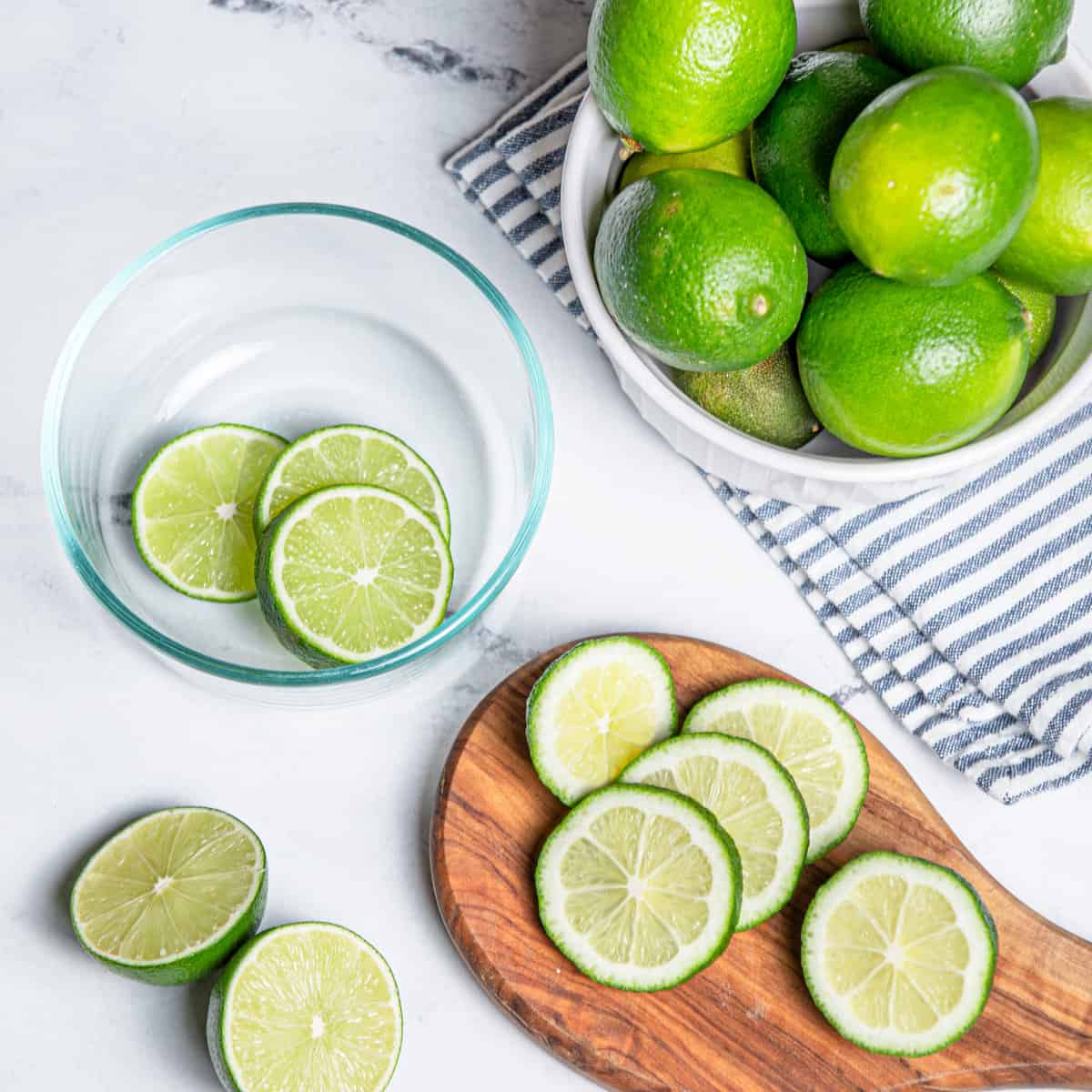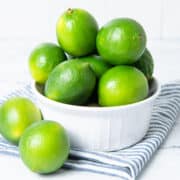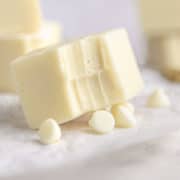Limes are a very popular citrus fruit and can be incorporated into all kinds of recipes. Their delicious zingy tang is instantly recognizable and the flavor of lime suits both sweet and savory dishes.

Jump to:
Similar to lemons but smaller, rounder, and usually green, limes are used in baking, cooking, and also to flavor drinks like mojitos and margaritas. Their acidic nature also makes them suitable for use in a range of household cleaning products.
Popular recipes using limes include key lime pie which can also be made as key lime pie bars, and lime fudge which is a favorite of mine because the tang of the lime contrasts beautifully with the sweetness of the fudge. If you've never tried lime fudge before, you just have to make the recipe - it's so good!
The juice of a lime also makes a great addition to salad dressings and sauces, and fresh lime juice is better than the bottled kind.
What are Limes?
Limes (Tilia x Europaea) grow in subtropical and tropical areas all over the world and come in different varieties including key limes, kaffir limes, and Persian limes. These are all slightly different, but mostly interchangeable in recipes. Since they're tropical fruit, they aren't really a seasonal item, although July through October tends to be the best time to buy them.
Persian limes are especially common, the most common type in the grocery store actually, while key limes and Mexican limes are also pretty easy to find. Limes are typically around 1.5 inches in diameter with a greenish-yellow or green skin. Most types of limes are high in both sugar content and acidity than lemons.
As well as being a popular dessert ingredient, these citrus fruits are used in chutneys and pickles, as well as in some seafood or poultry recipes. You can get lime juice in a can, concentrate or frozen.
Limes are believed to have originated on the Asian mainland or perhaps in the Indonesian archipelago, and Arabian traders probably took both lemons and limes into Africa and the eastern Mediterranean region. Christopher Columbus took lime seeds to the West Indies and then they spread to both Mexico and Florida.
As for nutrition, limes are rich in antioxidants and Vitamin C and also contain fiber, iron, calcium, Vitamin B6, potassium, and thiamin, plus niacin, magnesium, phosphorus, and riboflavin in trace amounts.
How to Choose Fresh Limes
You can find whole limes at most grocery stores, but how do you ensure you're buying the freshest ones? First of all, pick out limes that feel firm without being too hard.
A great way to determine freshness is to give them a gentle squeeze because the texture tells you a lot. Don't buy a soft, squishy lime because this is an indicator of age and the lime won't have as much juice.
Fresh limes should be bright green without any brown or yellow tinge, and they should have glossy, smooth skins. The heavier a lime feels, the more juice it is likely to contain, so compare a few and choose the ones that seem heavy for their size. Finally, I always make sure the lime has a citrusy, fresh smell.

How to Store Limes
Now you know how to select the freshest limes, but what's the best way to store them? Read on for some tips about extending the shelf life of your limes.
- Whole limes can be kept in a fruit bowl on the countertop or other dry places, out of direct sunlight, where they will last about a week. If they start to spoil, transfer them into the refrigerator instead.
- If you don't want to keep them at room temperature at all, or you won't be using them for a while, keep them in the crisper drawer of the refrigerator where they will last up to 2 weeks.
- It's a good idea to put the whole fruits in a plastic bag or wrap them in plastic wrap to help prevent moisture loss.
- Cut limes or lime slices should be sealed in plastic wrap or stored in an airtight container and used within a few days.
- Bear in mind that limes are sensitive to ethylene gas, so if you keep them near other fruits, they might spoil faster.
Another option is freezing limes. There are different ways to do this, depending on if they are whole, in slices, or just the lime zest or juice. This preserves the freshness of your lime for a longer time. To freeze juice, I freeze it in ice cube trays and then transfer it into a Ziploc freezer bag or sealed container.
Flash-freeze sliced limes on a baking sheet and transfer them to a freezer bag. As for whole limes, just put them in a resealable plastic bag and use them within 3 months for baking, cooking, or making cocktails or desserts.
Sometimes, if I cut limes to garnish desserts or drinks, I keep the leftover lime slices in a glass of cold water for up to a couple of days. You can also throw leftover cut limes in a big jug of water to make lime-infused water, to avoid unnecessary food waste.
How to Tell if Limes Are Spoiled
Rotten limes might have brown or yellow patches, along with a musty or unpleasant smell. They will be soft and squishy and also feel light because they aren't as juicy as fresh ones. Limes also shrink when they're spoiled.
Common Questions
Although both citrus fruits share some similarities, the flavor of lemon juice isn't exactly the same as lime juice. However, in many recipes, you can use one in place of the other. Bear in mind that lemon juice is less acidic than lime, so if a recipe needs a certain acidity level it might not work. However, if you're making cookies such as lemon biscotti, you can easily substitute lime to make lime biscotti instead, or how about making lime instead of lemon cookies?
Lime peels, also known as lime zest, are a popular addition to desserts. However, since the zest is rich in essential oils, this can mean the zest spoils faster than the juice and flesh of the lime. If you've removed the zest from a lime, the best thing to do is keep it in a sealed bag or airtight container in the crisper drawer. They should last up to a couple of weeks.
Key limes, also known as Tahitian or West Indian limes, are more yellow-green than regular (Persian) limes and they're smaller too. The flavor is sweeter and bolder than that of regular limes, but you can use regular ones in their place for a similar result if the grocery store doesn't have key limes. I've made key lime pie with regular limes before when I couldn't find the key limes, and it still tasted pretty good!

Fun Facts
- Do you know why Brits are sometimes known as "Limeys"? This is because lemon and lime was eaten by British sailors so they didn't get scurvy (a disease caused by a lack of Vitamin C) in the 1800s.
- India is the largest producer of limes, followed by China, Brazil, and Argentina.
- Thai, Vietnamese, Mexica, and South Indian are the cuisines using the most lime in their savory recipes.
- Head to Australia and you'll find Australian round lime, Australian desert lime, and Australia finger lime rather than the Persian and key limes.
Having a good idea about the best way to store limes means you can prolong their life, keeping them fresh, sweet, and juicy. Limes are used in so many recipes, both sweet and savory, as well as in drinks and cocktails. Limes might not keep for an especially long time, but if you know the best option for storing them, you can keep them fresh for weeks.














